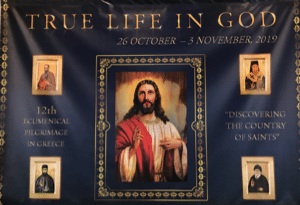The True Life in God 12th Ecumenical Pilgrimage in Greece
“Discovering the Country of Saints” October 26, 2019-November 3, 2019
(The Greek people are called ‘Hellenes’—which means: the people who walk with God.)
As a prelude to this account of our pilgrimage in Greece, a True Life in God Message given to a pilgrimage group who came from Athens and Rhodes to pray and learn the rosary in Patmos – The Apocalypse Island-on July 25, 1989 coincidentally relates directly to our week’s highlights:
“…awake! beloved ones; I am your Saviour, the Crucified, your Redeemer; feel My Love…
for your sake I have come to increase love and diminish evil; I come to provide your soul with all that it lacks; have no fear little ones, am I not Bountiful? am I not the Highest? so have confidence, for you are in your Father’s Arms; I, the Holy Trinity, am One and the Same;
abandon yourselves entirely into My Arms and allow Me to form you into Living Columns of Light, allow Me to share all that I have with you; I love you!” (True Life in God Message, July 25, 1989)
On the eve of October 26, 2019, our True Life in God 12th Ecumenical Pilgrimage began, this time in Greece. Our beach-front hotel was situated in Marathon: an ancient town near Athens, where the battle of Marathon was undertaken and won by the Athenians in the year 490 B.C. The beauty of the surroundings was breath-taking. Our hotel complex was built to look like a small village of single-standing hotel suites, which looked like small townhomes. The smoothed-rock outdoor walkways were lined with beautifully flowered trees, stimulating our senses with majestic aromas. God’s beauty in nature mirrored His beauty within our souls as we grew closer to Him each day during our eight-day pilgrimage. 720 people from around the globe arrived at the Golden Coast Hotel to participate in and share this journey towards unity with God and each other. It was a lively reunion, with people introducing themselves, rekindling friendships, and reacquainting themselves with one another. Among the crowd, there were 89 Christian clergy, 3 Muslim sheiks, 3 Muslim speakers, 1 Rabbi, and 2 Buddhist monks. Overall, the crowd comprised 21 Christian denominations and 8 non-Christian representatives: Buddhist, Jewish, Muslim (Druze, Sunnite, and Shiite). Some additional clergy members who intended to come could not get their visas in time for the event. Jesus’ work for unity is all encompassing, as He told Vassula time and again that He will bring it about. He states:
“…Vassula, have patience; I have said that My Word is like a rivulet flowing; then from a rivulet it will start rushing into a river, broadening, then it will be gushing and My Word will turn into a vast ocean, an Ocean of Love immersing your hearts with love and Love will be among you as Love;” (True Life in God Messages, February 4, 1988)
It was apparent that we all felt an immediate rush of the Holy Spirit as a warm wind sweeping through us and in our interactions with one another. It permeated our gathering that evening and throughout the week.
Sunday October 27, 2019
The full swing of the week began the following morning, on Sunday, October 27, 2019 with a very early breakfast and a welcome procession led by Vassula holding the crucifix and trailed by all the clergy. Each clergy member introduced himself, giving us a glimpse of his religious affiliation and residence location. We deemed the importance of their calling, giving respect to their clerical stature. They are God’s shepherds, the leaders of His flock.
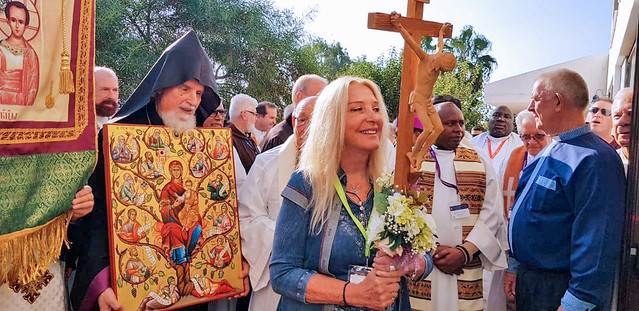

After the procession, Vassula welcomed all the pilgrims. In her speech, she reminded us that God does not distinguish between His creatures, and we should take His calls and warnings seriously: “So if people faced the reality of Love in God and in men, they would be led to love God and one other… If everyone realized that we live in moments of unbelievable Grace and Mercy and that God, with full power, is renewing His creation, we would never cease to glorify God night and day and our hearts would be inflamed with zeal! If people were paying attention to the Lord’s calling for conversion, all men and women would already be saints.”

After Vassula’s welcome, Father Vincent read the list of the pilgrimage’s participating countries. Every time a country name was read, the pilgrims from that country stood up with a shout of joy. It was touching to see people from a diversity of countries united lovingly in one room.
Greece, our host country, had its leaders, both in the church and in its military. A great Athenian leader, Miltiades, guided his troops towards victory– ‘Niki’-(the Greek word for victory) against the Persian army who wanted to conquer Greece in the 5th century BC. The Battle of Marathon, a documentary of it which we viewed via video, clearly depicted the strong, preservation-seeking Greek spirit. We noted in the documentary of the Battle of Marathon that the Greek people chose to fight for their spirit, their values and their culture with all their might, all their being; 3,000 soldiers marched all night into Athens to complete their victory, after defeating the troops in Marathon. They are a people with a passion for their beliefs and to the best of their ability will let nothing take it away. The Persian army was three times the size of the Athenian, yet the Athenians, using almost super-human energy, heroically strategized and physically guided the troops to victory. For us, our modern-day spiritual victory comes through Christ; and on this day, following the video documentary, four speakers from various denominations spiritually awakened us.
The first to speak was Archbishop Simon Atallah, of the Maronite Church. Archbishop Atallah focused his talk on Jesus’ commandment of love. He expanded on the novelty of this lesson, and explained how unity is the fruit of love: “This unity, at the levels of the family, the community, the Church and humanity, is the sign of the inner man, developed in us by the love of Christ and our rooting in Him.”
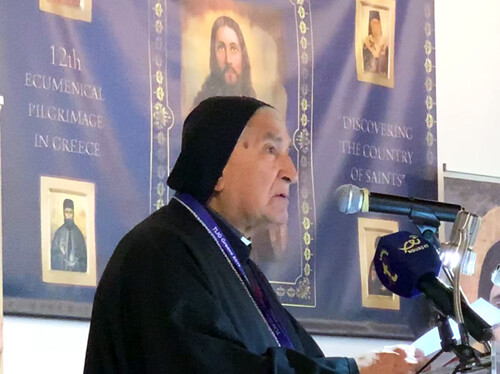
The second speaker was Bishop Riah Abu El Assal from the Anglican Church. He reminded us that: “Long years have been spent in the search for UNITY within the Body of Christ. Thousands of pages have been dedicated to this subject. We differ in our views about how the Spirit could create unity in diversity. Some try to exclude from God’s unconditional love those whom God insists on including in His divine compassion and grace. However, at that first Pentecost in Jerusalem, the apostles spoke in each of the recipients’ native language (Acts 2:6). One wonders if it is our lack of divine love that brought us back to Babel.” He concluded with a prayer from the letter of Saint Paul to the Romans about Unity.
The speech by Metropolitan G. Haddad, from the Melkite Church, explained how spiritual love is unconditional and without expectations. He highlighted that pride and the critical spirit is the great enemy of unity. As the final talk of the day, Rabbi Alon Goshen-Gottstein presented a Jewish teaching about the connection between Wisdom and Peace.

After concluding the morning talks, our pilgrimage tour brought us to the Acropolis, at the Parthenon, to view Athens from above. After Christ’s coming, the Greek people ‘the Hellenes’ gave Our Blessed Mother Mary the same name ‘Parthena’, to honor her virginity. Here, near the Acropolis, on the Aeropagus Hill, is where Saint. Paul delivered his well-known sermon to the Athenians and spoke about the inscription “to an unknown god.” (cf. Acts 17:22) We had the opportunity to see and hear how Greek antiquity prepared itself to receive Christianity as its foundation. To receive a glimpse of this history, our bus tour took us to see the highlights of modern Athens.
Upon our return to our hotel, we concluded our day with a Roman Catholic celebratory mass.


Monday October 28, 2019
Day 3, October 28, 2019, heralded-in another radiant day blessed at its morn with a Syriac Orthodox Liturgy after collectively singing the “Our Father” prayer in Aramaic. As we sang, our meditation on Jesus inspired us to understand that we, as the true, unified, body of Christ offer the Father our prayer in song. We are Christ’s manifestation, His manifested work for God’s Kingdom. At the liturgy’s conclusion, a few angelic voices sang a very spiritually driven song. As a remember to pray each morning, the organizers gifted us a three-daily prayers card, placed on each seat, enclosed with icon images of Christ and the Virgin Mary. At the tail-end of the liturgy/mass, we lifted our gifted cards in unison and the priest blessed them. Taken as a souvenir of our pilgrimage, each would add a blessing to our homes. Moreover, at this time, Vassula received a special award from Archbishop Mor Silwanos Boutros. Three post-mass/liturgy talks enticed us to listen, learn and more deeply understand God’s plan for humanity.

Metropolitan Athanasios Canepa from the Coptic Church spoke about the peace of Christ: “To make peace around ourselves, we need to firstly make it in our own hearts and in our intelligence.” He said that “without charity, no act of religion pleases God.” He explained that the Holy Spirit is the principal force of unity based on the words of Cyprian, martyr and Bishop of Carthage from 258 AD: “The Holy Spirit had in mind this one Church when he said in the Song of Songs: She is one, my dove; she is perfect; she is unique to her mother.” Believers, therefore, have only one house, only one Church. It is this house; it is the harmony reigning here which the Holy Spirit has in mind when we hear in the Psalms: God unites in the same house those who are united by the same thought, the same feeling; that is to say, the house of God, the Church of Christ, is inhabited by simple souls, united together by the bonds of a common faith. Hence, the Holy Spirit shows Himself in the form of a dove.

Pastor Jarle Tangstad from the Pentecostal Church of Denmark ended his speech with a beautiful conclusion:
“And always remember the wheel principle:
– Everything starts with the centre
– The unity is closest near the centre
– The better we understand each other and dare to trust each other, the further out we can reach and the bigger the wheel can be.
Frank Sinatra sang “I did it my way”.
Sorry, for us there is no My way but only His way – God’s way.”

Our third talk from Sheikh Mohamed Ali El Hajj– Shiite Muslim was read-out, as he had never obtained his visa to be with us. It began by mentioning the Muslim narrative: “Is religion anything other than love?” He linked that narrative to Jesus’ teaching about love. He also suggested a vision for the work of True Life in God and ended his talk by saying that it is our duty and responsibility to spread our way of thinking throughout the globe.
As we digested the plethora of information and insights gained from the day’s talks, we departed for Ancient Corinth to visit its ruins, the Corinth Museum, Epidaurus, its ancient theater, and the Sanctuary of Asclepius.
Saint Paul lived near the agora in ancient-Corinth for about a year and a half. People from many walks of life came to Corinth, so he was able to spread his message to those from other areas, and other lands. The honored Church of Saint Paul is now placed at the spot on which he preached. Moreover, Saint Paul worked during his stay in Corinth. We viewed parts of an ancient harbor where Saint Paul arrived and where he worked. Corinth is an isthmus, so it was an easy access for travelers. From the ruins we saw that this was a prime spot in Corinth for Saint Paul’s resonated and echoed message about the risen Christ to be spread across the world at that time. Corinth is situated at the edge of the northwest part of the Peloponnese. It is here where any and all goods and people could be transferred to the Ionian Islands and to Italy. It was called ‘akro’ (The edge). The Peloponnese has an amazingly beautiful landscape with rivers, high mountains and natural, hot springs. It is laden with olive and fig trees. From Corinth, we moved onto Epidaurus, an enormous, staged area: the oldest stage in antiquity, and then to an ancient healing area built within the nearby forest. The complex, dated between the years 600-800 BC was dedicated to the god Asclepius and it looked like the makings of a health resort. It was enormously big, with sleeping quarters and baths. Those who came to be healed would sleep, face-down, on a dedicated space on the ground, and try to dream about the god Asclepius, who intended to heal them. Through this history we saw and heard how this ancient culture valued healing from the divine. It prepared itself to finally receive Christ and the Holy Trinity into its culture, finding healing to this day through Christ’s intervention in their lives. On our return to the hotel, we dined and later had the opportunity to adore Christ in the Eucharist with an evening-capped Adoration.

Tuesday October 29, 2019
Tuesday, October 29th, was an early wake-up to the sunrise. As we hopped on the bus at 6:30am, hoping not to miss it, we were welcomed with happy faces and enthusiasm. It woke us up to what seemed as strength from a force beyond ourselves. We began our walk to the back of the bus, when a passenger looked over at us and said “Another day. Thank God we have a new day.” God indeed provides us rest, even within the movement of our journey, so we can participate in His gifts. Our energy comes from the unity that lies among us. All 720 pilgrims climbed onto a ferry boat, at the port of Piraeus, and headed towards the island of Aegina. Aegina is in the middle of the Saronic Gulf, between the coast of Attica and the Peloponnese (exactly in the middle). It is called the Argo-Saronic Island. It is the largest of the Saronic islands, 85 square kilometers with 13,000 inhabitants, many from Athens who have a second home in Aegina. The famous monastery of Saint Nectarios, with a recently built church of this modern-day saint, stands in Aegina as the largest church in all of Greece. Behind Saint Nectarios’ Church is the Church of the Holy Trinity. At the monastery, we took some water from the blessed springs near Saint Nectarios’ tomb and then walked to the room which housed his tomb. We placed our heads against the saint’s tomb. Indeed, we heard his heartbeat! (It was a definite sound of a heart beating.) Other pilgrims heard knocking sounds. This occurrence is a phenomenon experienced by many visitors.

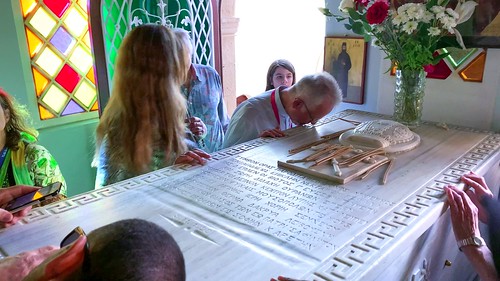
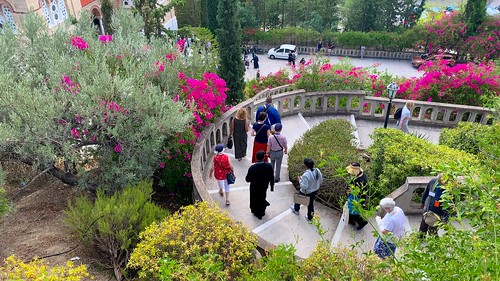

We listened and imbibed stories from our tour guides about Greek tradition through its saints. Saint Nectarios, one representation of the saints in Greece, is known as the patron saint of healing, as well as for athletes and gymnastic instructors. He focused on the health of the body as well as the soul. During his life, he followed a personalized exercise routine within his daily schedule. He was educated on the island of Chios and was asked to teach at a seminary school in Athens. He was loved by many but was fiercely persecuted by other Orthodox Church clergy because of the closeness he had towards others. When the boys at the seminary school fought, he would fast. Hence, the boys would not fight because they didn’t want him to suffer without food. Finally, Saint Nectarios was asked to come and help build this spectacular monastery which was founded at the early turn of the century, 1904. In reflection, we can surmise that Saint Nectarios was a man who lived his life in service to others for the glory of God. His sacrifices brought those he encountered closer to God’s love.
The saints in general are spiritually cherished in the Greek Orthodox tradition. So much so, the Greek people celebrate names days in place of birthdays. Up to the year 1983, the Orthodox Church and therefore, by default, the Greek parents would name their children after a saint. If by chance a child did not have a saint’s name, the church would change it to a saint’s name for his/her baptism. After the year 1983, the church allowed other Christian names to be used. Overall, just like Miltiades and his heroic Athenian army at the Battle of Marathon, the Greek Orthodox saints are considered the protectors of the country. On our trip home, our friends began singing towards the end of our two-hour bus drive. The melody of their voices added a comforting, reassuring sentiment that we are in unison, walking towards God. God is among us and we choose to walk with Him, as ‘Hellenes.’ Our opportunity to adore Jesus in the Eucharist after our post-trip Catholic mass rounded-out our day of thanks.
Wednesday October 30, 2019
We welcomed in our Day 5-Wednesday, October 30, with a Maronite celebratory mass after collectively singing the “Our Father Prayer” in Aramaic (Abun Dbashmayo). This mass’s sermon emphasized that what we say determines who we are. With the help of the Holy Spirit, our words are the words of the Spirit. If we let go of ourselves: our will, our passions, our desires, the Holy Spirit will lift us towards inner peace. The manner we view and react to others determines how we see and find God in others, as His creation. The objective is to embody a True Life in God. The talks that followed inspired us to more deeply live our faith, our values and our humility towards others.
Venerable Suddhananda Mahattero’s talk (Buddhist Monk) was read by his assistant as the Venerable’s health forbade him to be with us. His talk imparted a call to respect the beliefs of another for conflict resolutions. “All religions trace a path leading to a spiritual state of mind that is peaceful, disciplined, ethical and wise…Divine Love is the greatest gift in the entire universe.” He further stated that he has been maintaining an excellent relation with Vassula for more than twenty years, awarding her and the True Life in God associates the peace award. He calls out to us to continue providing a conducive atmosphere for peace, as we are all one big family.
A talk given by Camel Bechikh, Sunni Muslim, brought us to awareness that modernity drives hearts away from God. The speaker defined more precisely what love is, as never before has a human individual felt so alone as he/she does in our modern day. Religion connects man and God vertically. With God, we have a link, a divine bond. The link/connection requires effort; we need to build, preserve, invigorate and maintain it. As we confide in Him, we grow in Him-heart to heart-and He invites us to share the same reality with other human beings. Divine love is available everywhere, as it is the catalyst that connects us to reach the divine essence of those with whom we communicate. Vassula’s gigantic work of spreading the True Life in God Messages is an impulse of the love of the soul. Through our prayers we invoke God’s grace to fall on all people, to give Him the strength to continue His work of Love.

The next speaker, Archbishop Antonio Ledesma, Roman Catholic Church, spoke about a means one obtains Christian Unity. When we collectively invoke the Holy Spirit, we are calling on the spirit of unity to imbed our culture and our traditions. Within our dialogues, we share ourselves, respecting the traditions of those with whom we speak. We are all enriched by our life’s experiences and we share our joys and sorrows. Moreover, charity, the guidance against discrimination, accompanies us towards peace in today’s wounded world.
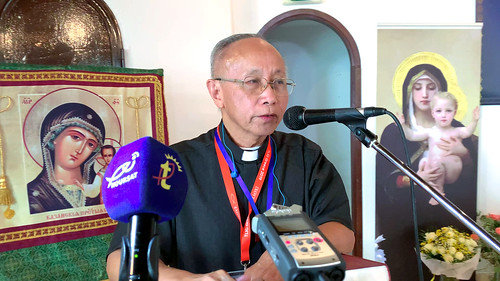
Bishop Markos Gebremedhin CM, Catholic, from Ethiopia, claimed, “God’s Love is steadfast, unchanging, unconditional and rooted in His own nature…The fact that love flows from God’s nature is of utmost importance to our understanding of our duty; we must love God and love our neighbor…Loving God invites us to reflect and see others through God’s eyes and His experiences. Only God-centered collaboration and togetherness can bring true togetherness and unity… All of us have to work towards the unity of all Christian and non-Christian brothers and sisters so that all may be realized as God desires; He who is Love.”
The fourth speaker of the day, Sheikh Daneel Abdel Khaleq, Druze, indicated that God created us to glorify Him. His love for His creation is our treasure and it grows and develops in people, manifesting in our love for one another. Our faith is our sincerity towards loving God. He created a world that comes from love without self-interest.


Bishop Choucrallah Nabil El Hajj, Maronite Church, as our fifth speaker of the day, added another angle. Our God of love has one design and that is to reach the spirit in each of us so that we can live together in a complimentary way, in brotherhood. Our spirit of brotherhood extends beyond our differences.

On our break at the beachfront Cafe, we encountered what seemed like an analogy of what we absorbed at that morning’s talks. Two French ladies received their order of coffee, but after seeing what the barista gave us, discovered something new: frappe-a famously Greek cold coffee. They simultaneously asked us what it was and claimed that they looked forward to trying one while in Greece. Our experiences on this pilgrimage are a renewal, a receiving of something new, which lead us to an opportunity to pull away from our set perspectives to reflect, unwind and regroup ourselves. The participants seemed receptive to the sense of well-being given to them at this pilgrimage; it was something that admittedly isn’t otherwise accessible to them. Like a father readily told us in his talk, “we all come with fractured selves to quench our thirst for wholeness—for a divine element to penetrate and cleanse us.” The events of each day seemed to unfold naturally. The interactions among the participants seemed to have a purpose, a movement towards something larger. It was obvious that the chats and conversations among the people were not in vain or adulterated by some personal ambition. Some participants randomly invited another to share a coffee just to meet.
Our trip to Nea Makri later this day showed us that as we grow closer to God, we recognize that the saints are alive and living among us. Saint Ephraim of Nea Makri was born a poor boy, in the early 1400’s. His parents took him to live at a monastery to prevent him from becoming a ‘genitsaros’. During the Turkish occupation, the Turkish army would kidnap the Greek boys and raise them to kill their kin, hence giving them the name, ‘genitsaros.’ He grew to love God, devoted much time to prayer, hid himself from danger, but was found and hung upside-down from a tree to die by the Ottoman rule. His relics and intercessory prayers have helped many. He is the patron saint of addictions. Saint Ephraim had the ability to heal those he encountered, and we, as we learn and grow in our love for God, with the saints as our models, seek to help each other. The pilgrim participants desired to offer each other emotional assistance, comfort, healing. I would hear people randomly saying “I will give you my scarf” …or “I have an aspirin.” Generosity in heart and in spirit is a recognized gift from God.
`
Thursday October 31, 2019
On Thursday morning, October 31, we sang the beloved “Abun Dbashmayo” (the Our Father Prayer in Aramaic) and then celebrated the Eucharist with a Melkite Byzantine Mass. Everyone was able to follow the English text of the Byzantine Liturgy through a PowerPoint projection. The homily focused on the meaning of the Sacraments.
The talks that followed inspired us to grow into an understanding of God’s Will. Archbishop Mor Silwanos Boutros – Syriac Orthodox, reminded us that love must not be merely words that we utter, but actions that we do in imitation to our Lord Jesus Christ; it is our responsibility to love our neighbor in our societies. Father Bo Westergaard, Lutheran, shared with us the Swedish experience of a True Life in God community lived in love. Sheikh Iyad Abdallah – Sunni Muslim, introduced us to two mystics in Islam, Rabia Al-Adawiyya and Jalal ad-Din al-Rumi, expressing how they loved God and yearned for Him. Pastor Said Oujibou, Evangelical, told us the story of how his faith pushed him to love a person whom he would normally hate. Lastly, Venerable Michael Tao Chan – Buddhist, shared with us how he takes care of his mother who suffers from Alzheimer’s disease. His patience and insights were very valuable. We had never heard of anyone having such love towards an Alzheimer’s patient.


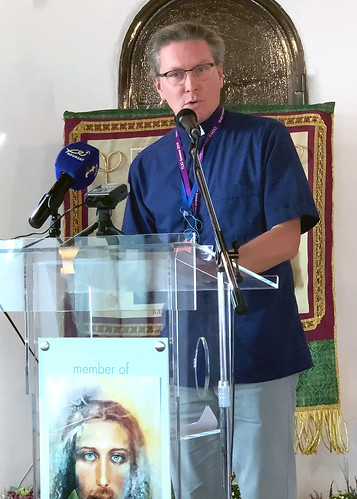

It is a blessing to receive spiritual food, as these talks have given us, yet there are many with physical needs that need our help for sustenance. In 1998, Vassula received a message from the Virgin Mother asking her to feed the poor, which was followed by a subsequent message from Jesus on March 27, 2002, about the Beth Myriam Project:
“…establish Our Beth Myriams everywhere you can; lift the oppressed and help the orphan; protect Me, rescue Me from the gutter, shelter Me and feed Me, unload My burden and fatigue, support Me and encourage Me but above all love Me; all that you do to the least of My brethren you do it to Me …” (True Life in God Messages, March 27, 2002)
Our speaker on behalf of this mission, Heidi Kyhl, our Beth Myriam coordinator, informed us that twenty-five Beth Myriam venues in eight countries serve a half- million people yearly. Those served are socially disadvantaged, sick and elderly. Beth Myriam provides them with clothing, medical treatments, and schooling. The program is run entirely by volunteers; hence it will grow if more people share the practical work: cooking, buying and donating needed items, donating funds or speaking about and/or praying for the program. A support of sixteen Euros every month alone can offer a difference for those in need.
Our spiritual nourishment gives us the energy to give of ourselves. Sara Annunziata, our book distribution coordinator, presented a talk about the True Life in God books, our spiritual nourishment; they are accessible to us through the True Life in God website. Finally, through Mark Jordan, Father Vincent Cosatti, and Neil Labbé de Montais, our website designers, we were blessed to hear that our new True Life in God website will be launched on November 28, 2019.
At the same time, a round table meeting for the clergy of the various religions and denominations was held at the basement of the Conference Hall. It was filmed by Noursat the Lebanese Church TV. The host, Lea Maamari, asked the clergymen various questions about Unity, Coexistence, Peace and True Life in God.


After lunch, we all took a bus-ride for a visit to the Monastery of Saint Porphyrios, claimed as the Saint who heals those in depression. The busses left a bit earlier than expected; we missed our bus, but we thankfully hopped onto the last bus, catching it after everyone had boarded, as it was moving towards the exit. As newcomers on ‘the French bus,’ we were stunned by the energy of the passengers. They were all very lively: talking, singing, praying the rosary in unison. Towards the end of the trip, several them grabbed the microphone to tell about their pilgrimage impressions and about something special that happened to them while on this pilgrimage. Their spiritual faithfulness seemed to bring about this obviously enormous energy.
We found our bus-group after reaching the monastery and were taken-away into the main church by our tour guide. Saint Porphyrios is a modern-day saint, like Saint Nectarios. He too was a healer with clairvoyance. Ordained a priest at the age of 20, he eventually became a ‘geronda’ (an Elder within the monastery). He had the ability to read and heal souls: reveal what happened in each soul’s past, along with reading the soul’s concerns of the day. The church we entered was very new; we witnessed the iconographer drawing the walled icon of the ‘Theotokos’ (the Virgin Mary) behind the ‘iconostasion’ (the sanctuary). We then venerated Saint Porphyrios: knelt at the bedside in his cell and prayed for those in need. As we began to depart from the monastery, we chatted briefly with our bus-guide who disclosed that our pilgrimage inspired her to go to confession for the first time in her life! Praise be to God. On the way to our hotel, we visited a local winery in the area of Malakasa. Many pilgrims bought wine, ouzo and other very delicious vinegar products. Simultaneously, while we were visiting Saint Porphyrios’s monastery, our non-Christian participants departed for Sounio to visit the temple of Poseidon and enjoy another jewel of Greek history. We returned to the hotel with stories in mind about Saint Porphyrios, recognizing that our path towards our Lord is rightly directed through our saints. We thank the Lord for their guide. Our day was topped with a time for Adoration.
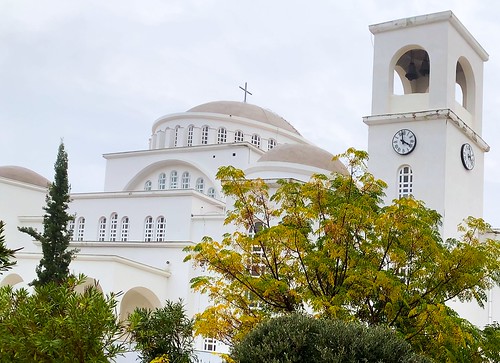

Friday November 1, 2019
Day 7-Friday, November 1, heralded in the first of the month. The Greek people greet one another saying ‘Kalo Mina’ (have a good month) at the first of each month. The Orthodox Church also commemorates the first day of each month with a liturgy. We began our day with songs of praise and a glory to God by singing ‘Abun Dbashmayo.’ Awakened to a new day, and a new month, we were inspired by two significant talks. Father. Cosatti – Roman Cathlolic Church, delivered a very beautiful speech building upon this sentence “Love is no longer love if it is not shared.” Sheikh Nizam – Druz, explained that in order to reach the Love of God, our journey needs several elements: Love – beauty – asceticism – worship – morality. He explained each element separately. An Ethiopian Mass followed which invigorated us to depart for the Monastery of Daphni.


The Monastery of Daphni encompassed a church that was built in 1008 A.D. It was an amazingly large, concrete structure with remnants of walled icons, some refurbished. An entire section of icons at the entrance (‘the Narthex’) was dedicated to the life of the ‘Theotokos’ (the Virgin Mary), and the ‘Pantocrator’ (Jesus’) icon located at the ceiling of the church’s nave, looked a bit stern. Christ appeared more ‘Greek’ in this image. We explored the ruins that depicted monastic life and looked forward to the unfolding of the day’s events. Our hotel-return along with our lunch and Adoration-time led us to partake in individual blessings circulating with the Blessed Sacrament, and Prayers invoking the Holy Spirit lead by Father Teófilo Rodríguez. After the Adoration period, a video presentation was shown of our True Life in God friends and supporters who went to the Lord: priests and dedicated lay people. The evening culminated with a Healing Service, given to all the pilgrims one at a time. Members of the clergy and Vassula were lined along the staged area and blessed each pilgrim on the forehead accordingly. Some pilgrims fell to the ground ‘resting into the Spirit.’ Our events for the day ended, but what remained in our hearts was that humility allows us to understand another person, and what entails as God’s will.


Saturday November 2, 2019
On our last day of excursions, Saturday, November 2, Day 8-the day before our pilgrimage departure, at breakfast time, before we gathered in prayer, as we felt a sentiment of longing to hang-onto the unity we experienced this week, one of our pilgrimage friends smilingly and enthusiastically greeted us by saying that it is important to share the experience we felt this week with others. We do not have to leave this experience of unity; we expand it. This interaction was an example of how we communicated with one another throughout the week. Somehow, the communication that transpired between individuals was what one needed to hear or say for an emotional, physical, or spiritual benefit. Our day’s events began with our morning prayer: ‘Abun Dbashmayo’ and morning talks to rev us into the day.
We were blessed to hear Patriarch Sako’s speech, a Cardinal of the Roman Catholic Church and the head of the Chaldean Church. In his talk, the Patriarch defined love in these words:
– Love lives in truth and not in an illusion; it is frank and sincere; it knows no falsehood and no complexes.
– Love is selfless; it does not look for self-interest, and it ignores the mentality of “Give me and I will give you back!”
– Love, when it overwhelms our being, makes us grow wonderfully healthy.
– Love, when it lives in us, binds our life firmly even when there is some brokenness! Is not the Eucharist the mystery of Love? Christ offered Himself graciously for us whom He loved so much (cf. John 13: 1).
– Love is emotional, it is not depressing, worrying or frustrating; it is big-hearted and patient, refreshing, participatory, creative, and always renewed. It cannot be turned into an “article for sale!”
– Love does not grieve anyone and does not efface one’s personality; it does not do anything adverse and does not weaken in the face of hardships and pain; it does not believe in the cessation of life, but makes hope, confidence, vitality, energy, peace and joy shine in us. Love is a feast, a celebration and openness to the promising future!
– Love is a complete and harmonious maturity. Love does not need to speak, it expresses itself! The letter kills, but the Spirit gives life (2 Corinthians 3: 6), it doesn’t wear out; it does not get tired, nor become introvert.
– Love gives strength and momentum to face challenges and overcome difficulties, and it is the strongest link between us as human beings, and between us and God our Creator.
– Deep and true love is a reflection of God’s love for us, so we are called to educate ourselves.
– Love is a dynamic project that amazes, delights, elevates and transcends through gradual, not mechanical, integration.
– Love is free self-giving: a person who loves is not afraid to give himself up in a creative, life-loving marriage, or in a free and fertile consecration in the service of the priesthood or a monastery: through the body, soul, heart and mind. We sacrifice ourselves for the one we love and accompany them to the end.
From this perspective we should understand Jesus’ words: “Whoever loses their soul will find it” (Matthew 16:25).
– Love is compassionate closeness, turning everything into a great good. That is why Paul asserts that love never fails!
Following the above talk, Father Teófilo Rodríguez, Roman Catholic Church, spoke about the Unity of the Priesthood in the Mystery of the Trinity.
Next, Sheikh Ayad Kazem – Shiite Muslim said in his talk: “The essence of the divine purpose of the heavenly religions is to spread love in societies and among people based on morality; this is what the prophets and apostles have embodied throughout history. (…)Thus, the job of all the apostles, (messengers), who follow the example of Jesus and Muhammad and the rest of the prophets, is to consolidate the concepts of love in God, and of the “coming closer” of all the souls, through love, among all religions, in pursuit of a society of peace, love and prosperity.”
Sheikh Valsan – Sufi Muslim then told us about his beautiful experience with the Catholic monks who are his neighbors.
As for Vassula’s farewell speech, our finale, we could say it was Jesus’ speech because it was all based on His Hymn: True Life in God. The following is taken from her talk:
The question is: Is it so difficult to understand that we all descend from one source and that is, from the divine, even if we are different in shape, in color, tradition,
beliefs, and culture? How is it that we have easily forgotten who it is that breathed in us the same Breath of Life which He breathed in all beings?
We must be an example to others, showing that humans can live in peace and harmony, and can reconcile with each other. We must learn to be merciful and learn to forgive. Can we truly unite and reconcile with one another? Yes! Yes, we can unite, so long as we learn to love by reminding ourselves of our divine origin, by reminding ourselves what Jesus said to His disciples: “I give you a new commandment; love one another, just as I have loved you. It is by the love you have for one another that everyone will know that you are my disciples.” (Jn13:34-35) We must remind ourselves to become the Image of the living God, who has no trace of impurity, no trace of prejudice, no trace of vengeance, no trace of hatred. After absorbing these talks, one pilgrim participant, a long-standing reader of the True Life in God Messages, admittedly felt the Holy Spirit upon her.

After Vassula’s finale speech, our trip to Mycenae and the events that followed deepened our awareness of ancient Greek history and of ourselves. The ancient Greeks’ continual, ongoing attachment towards something divinely larger than themselves colored everything we saw and heard. The Mycenaean rocks were called the ‘Cyclops’; they are so large, heavy and high, that, as the verbally handed-down story tells us, the ancient Mycenaean wall must have been built by the Cyclops. Across from the Mycenaean Wall stands the face of the great Peloponnesian King Agamemnon, lined as part of the large mountain range. From Mycenae we toured to the famously quaint town of Nafplio, once chosen as the potential capital of Greece, before claiming Athens as the capital.


Upon our return to the hotel, we celebrated the Eucharist with a Catholic Mass. The priest’s sermon spoke about Zacchaeus: a tax-collector, a wealthy man of status, considered a sinner by his peers, and short in stature. He recognized that something was missing in himself; hence he climbed a tree to find Christ so he could fill his void. His desire led him to Christ. (cf. Luke 19:1-10) From this account we note that since we are all an embodiment of His creation, we need to accept, respect, and love those who might be otherwise considered apart from God. We, in turn, need to desire to find Christ in ourselves. We all have a void to fill.
Our pilgrimage attempted to fill that void. Some lukewarm pilgrims, with little attachment to the True Life in God Messages who came for a time of leisure, felt the surge of the Holy Spirit within them. They found a desire to hear more about the True Life in God Messages. Another newcomer claimed that the pilgrimage deepened his understanding of unity among the churches. Moreover, a third newcomer professed that she felt God’s Spirit infused our collective spirit. She felt unity, cooperation and fellowship from pilgrims coming from various countries, tribes, denominations, and beliefs. Additionally, newcomers met other first comers who were lit by the loving fire of the pilgrimage. The communication between people was so connected that one non-English speaking lady acknowledged, “I found that my limited vocabulary in English was not a problem; people helped me to express myself. I was so happy to meet brothers and sisters from all over the world!” One pilgrimage veteran enthusiastically confessed, “I felt the pouring of Jesus’ Flame of Love embrace and penetrate my soul so deeply, very gently, and brought me so much joy! He turned my walk to a dance with His Harps! Praise the Holy Trinity.” Another True Life in God reader claimed that while on this pilgrimage he felt that God truly was “Life”; he experienced life, joy and peace during the events of this week. One of our priests, a newcomer, claimed that he never felt so much love in all his life! The overall sentiment that came from those who have participated in many other pilgrimages was that this entire pilgrimage was more than what had been expected. We ended the week-long event with lively Greek dancing. Our unified line-dance ushered in the lift we felt the entire week!
We can truly say that our pilgrimage hosts worked tirelessly so that we could partake in this week-long experience of unity. In general, The True Life in God volunteers who organize meetings for Vassula, translate the messages, volunteer their time to sell books, create the website, and manage the Beth Myriam, expect nothing in return. Their work in-itself is meaningful. Above and beyond all, we must extend a warm and continual ‘thank you’ to Vassula who tirelessly transmits Jesus’ Love Hymn to our love-starved world! God Bless Vassula abundantly and always!
“…My Spirit indeed fills the whole world to brighten this darkness and give Hope to those who grope their way in this endless night; beloved, with Heaven your homeland, and earth your pilgrimage, all the more reason to rejoice and to hope;” (True Life in God Message, February 7, 1991)
Praise be to God and our Intimate Lord, Jesus Christ!
Written by TLIG volunteers- Magdalene and Jonathan Kosoy, with the assistance of Magda Skalová, Lucien Lombard, Laura Panayotou, Theodora Konidari, Chadi Choufani, Lisa Arman, Marianne Poulos, Sara Annunziata, Tereza Perri, and Georgia Klamson.


